Ellen Sinel and Kate McConnell at AMZehnder
Ellen Sinel’s and Kate McConnell’s work will be shown at Wellfleet’s AMZehnder Gallery (25 Bank St.) from Aug. 13 to 23. The opening reception is on Saturday, Aug. 13, 6 to 8 p.m.
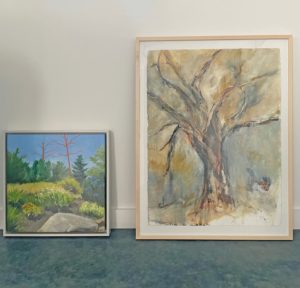
Sinel paints portraits of Truro’s natural landscapes, which face an uncertain future due to climate change. She will show eight medium-to-large oil-on-wood pieces and several small pieces done with resin. In almost all her pieces, one finds “red zips” — red lines slicing through the foreground or background.
“They represent the unknown,” Sinel says. Whether the zips are a positive or negative force is up to the viewer.
McConnell typically paints on canvas or board, but her 15 pieces are mostly oils on watercolor paper — plein air landscapes of Provincetown, Truro, and Wellfleet, as well as some stand-out scenes and subject paintings. Some lean toward abstraction, says McConnell.
She adds that she loves depictions of old trees. Despite their age, she finds the trees to have a “freshness” and “a life of their own.” Her How to See a Tree is done with oil paint, oil stick, and walnut ink. A bare tree, painted in gray, brown, and blue, emerges from its smudged background like an apparition. —Eve Samaha
Emily Yong Beck at Gaa Gallery
Emily Yong Beck works with cartoon imagery through a series of unsettling ceramics in her show “Lions & Lambs” on view until Aug. 29 at Gaa Gallery (494 Commercial St., Provincetown).
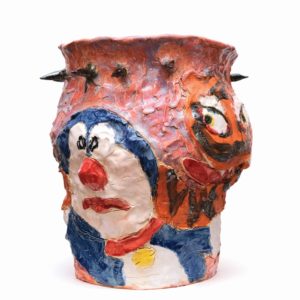
The show’s title aptly describes the contradiction Beck sees in cartoons. On one hand, her imagery conveys the playful veneer of childish productions. Betty Boop winks dramatically, Dumbo’s ears are large and silly, and the colors look like they’re pulled from a crayon box.
A closer look reveals a menacing violence in her cuddly characters. Thumper clutches a missile, his eyes aggressive and determined. Spikes line the edge of a pot depicting Horangi and Doraemon. It’s a wry commentary on themes of violence running through children’s entertainment across cultures.
The shoddy, childlike construction of these seemingly functional objects and their sloppily painted surfaces suggest a degree of instability. Beck challenges the innocent mythology of cartoons, reconfiguring them as vessels containing a complicated mix of interests from a dominating media culture to political propaganda. —Abraham Storer
Paige Turner at Post Office Café
Drag queen and spitfire Paige Turner performs a slumber-party-themed show, “Tucking Myself In,” on Monday, Tuesday, Wednesday, and Saturday evenings at the Post Office Café & Cabaret (303 Commercial St., Provincetown) at 10 p.m. through Sep. 10. Tickets are $35 at postofficecafe.net.
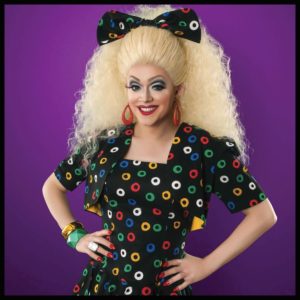
The show, entirely live sung, includes musical theater classics from Hairspray, ballads by pop divas like Celine Dion, and top-chart hits from newer pop princesses like Taylor Swift and Carly Rae Jepsen.
Self-described as “the illegitimate love child of Pee-Wee Herman and Barbie,” Turner performs primarily in New York City and Provincetown. The blond bombshell brings cozy, snuggly vibes to a late-night show that features Turner’s own “drag-tastic” pajamas. —Paul Sullivan
Robert Pinsky’s PoemJazz at Castle Hill
Robert Pinsky, who served an unprecedented three terms as U.S. poet laureate from 1997 to 2000, will present his PoemJazz at Castle Hill (10 Meetinghouse Road, Truro) on Wednesday, Aug. 17 at 6 p.m., with Grammy Award-winning pianist Laurence Hobgood, saxophonist Stan Strickland, and Catherine Bent on cello.
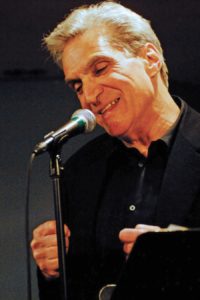
Pinsky’s study of the way poetry exists in the body often turns to sound. His book The Sounds of Poetry: A Brief Guide was published in 1998. “Poetry is a vocal, which is to say a bodily, art,” he wrote.
PoemJazz is Pinsky’s inventive combination of spoken-aloud poetry and jazz, which musicians play alongside the speaker. Music and language join in midair and exchange definitions — jazz speaks and the voice plays. A book and CD signing will follow the event. —Dorothea Samaha
Celeste Lecesne Casts a Spell at Truro Vineyards
Celeste Lecesne believes we can all find the inner strength to confront the climate crisis — as long as we’re not afraid to connect with our inner fairies: “I think all of us, not just me, have some component inside of us that is the source of our magic.”
The writer, actor, and producer’s latest work, Poof!, “conflates the queer story and the history of fairies,” Lecesne says, because as they see it, queer history provides important experience and lessons in social change that could inform climate advocacy.
In the show, Lecesne, Miles Tripp, and Michelle Rodriguez play three fairies who have some advice for humans on how to cope with the crisis. They want us to ask ourselves, “How have we pivoted and been resourceful in terms of survival?”
Lecesne enjoys playing a fairy: “I get such a kick out of it — when I was a kid, that’s what they called me. It’s such a big reclamation of myself.”
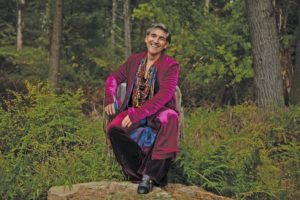
Poof! is not meant to educate the audience but to call it to action, Lecesne says.
The New York-based Ancram Opera House commissioned the piece last year. It was first performed in the opera house’s garden beneath a 200-year-old oak tree — “the best co-star ever,” Lecesne says. The outdoors “becomes another character in the play.”
The show, part of Twenty Summers, will be outdoors (b.y.o. beach chair) at Truro Vineyards on Friday, Aug. 12. Doors open at 7 p.m. so there’s time for drinks and eats from the Blackfish Crush Pad. Tickets are online at 20summers.org.
Lecesne wrote the 1994 film Trevor and four years later, with director Peggy Rajski and producer Randy Stone, founded the Trevor Project, a California-based nonprofit that focuses on suicide prevention among LGBTQ teenagers. Lecesne went on to start the Future Perfect Project, which offers creative workshops for LGBTQ youth.
“What I’m trying to do with the show is say, ‘Where is that magic inside of you, and you, and you?’ Because we need it now,” Lecesne says. “I think we’ve got to find some hope in ourselves and inspire each other.” —Greta Magendantz
Valerie Isaacs at Provincetown Commons
Painter Valerie Isaacs shows her oil paintings in a series called Paintings of Provincetown at Provincetown Commons (46 Bradford St.) until Aug. 21. The opening reception is on Saturday, Aug. 13, 5 to 7 p.m.
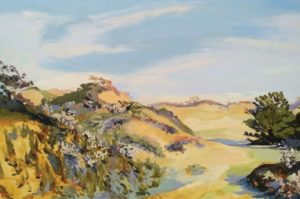
The oil paintings are done from observation of Provincetown’s bay, oceanside beaches, docks, wild dunes, and buildings.
Isaacs says she works “straight from life.” If she decides a painting needs something else, however, she’ll add it. While some parts of her pieces are done in striking detail, other parts deal more in shape and color — the idea of something, rather than the thing itself.
She says she’s interested in painting reflections on the water. The contrast between clear detail and blurred lines occurs at the water level. She’s also intrigued by “big space.”
In her 2022 painting Dunes in Spring, the sky, washed in a light blue, forms the background to Provincetown’s rolling dunes. The sand and its wildflowers are painted in golden and green hues. The piece is slightly abstract, while feeling realistic.
The Commons show includes 30 paintings. All were painted in the last four years and a third of them in the last year. —Eve Samaha
Bert Yarborough at Berta Walker Gallery
Bert Yarborough’s ecstatic show on view through Aug. 20 at Berta Walker Gallery (208 Bradford St., Provincetown) ranges from pieces he made as a fellow at the Fine Arts Work Center in 1976 to landscape-inspired paintings created this year. Surprisingly, the expanse of time covered makes for a cohesive show, revealing the artist’s consistent obsessions.
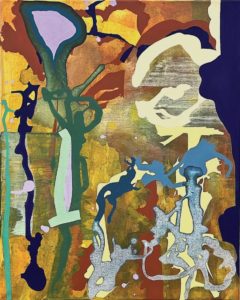
The earliest work is a series of photographs of a land-art sculpture he made in upstate New York. He stacked sticks into columns, creating what he describes as totems. The form reappears in recent paintings as a tall mound-like object. In some of the paintings, the shape is composed of intersecting lines and drips of paint. In others, the shape functions as a cavernous void or a teetering mountain.
An inventive curiosity guides his practice. In one series, inspired by an African mask, he worked on teardrop-shaped panels. In another, he painted loose abstractions on surplus bunk covers he purchased at Marine Specialties.
Chief among Yarborough’s influences are three places he describes as his “holy trinity”: the Provincetown landscape; Nigeria, where he did a Fulbright fellowship; and Italy.
In his landscapes, many imagined and felt, he draws from the rich saturated colors of Nigeria and medieval Italian painting. In addition to influencing his palette, the otherworldly atmosphere of medieval art and the shamanistic spirituality of Africa haunt his work. The last room of recent paintings embodies this influence best. Here, he creates his own sort of magic, transforming canvas and pigment into something radiant and miraculous. —Abraham Storer



